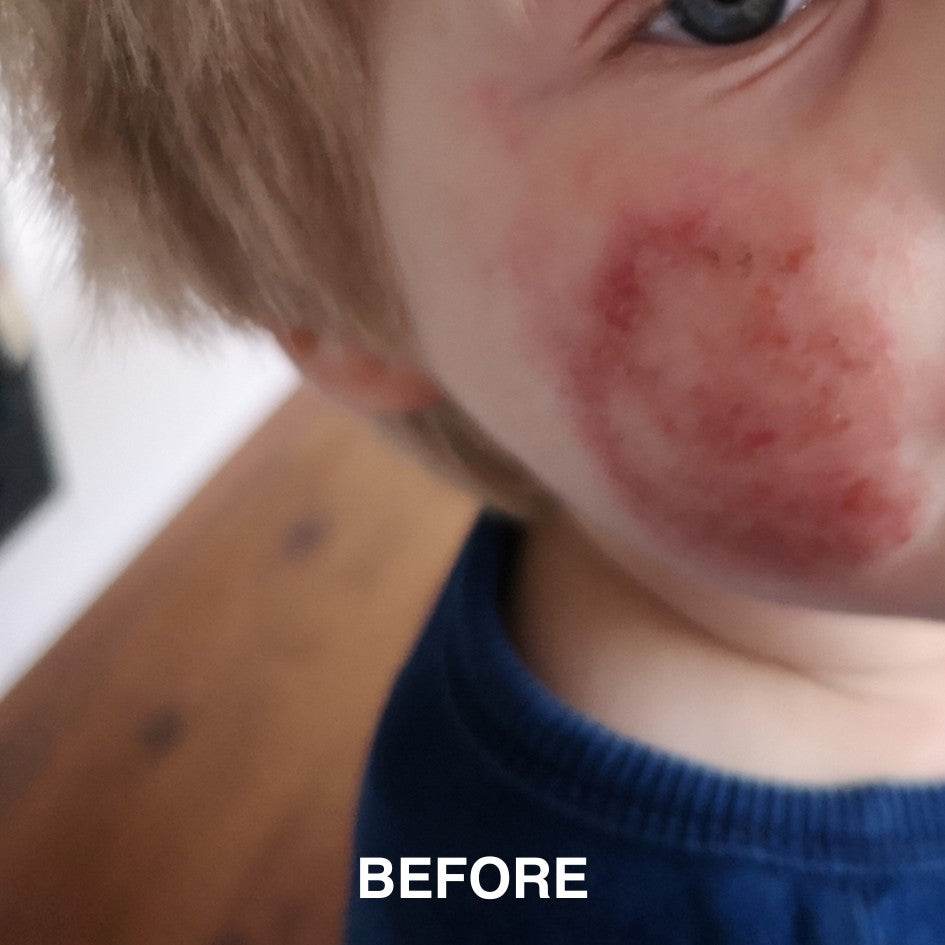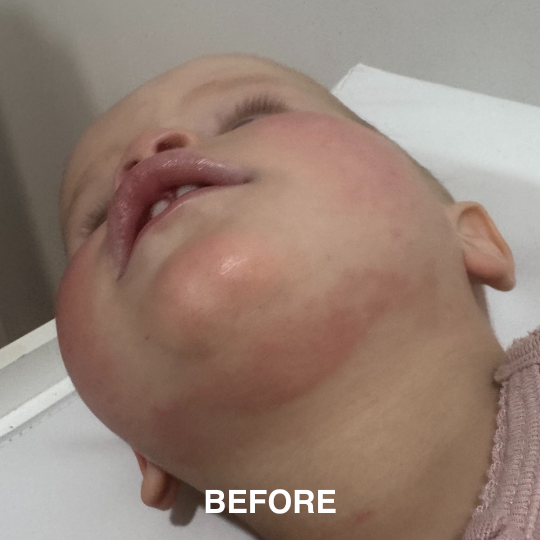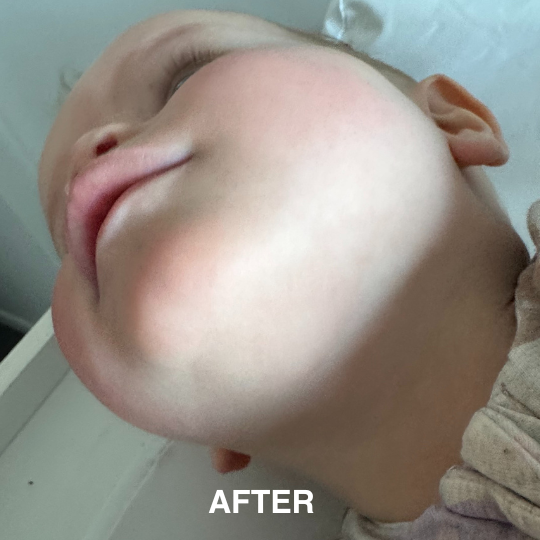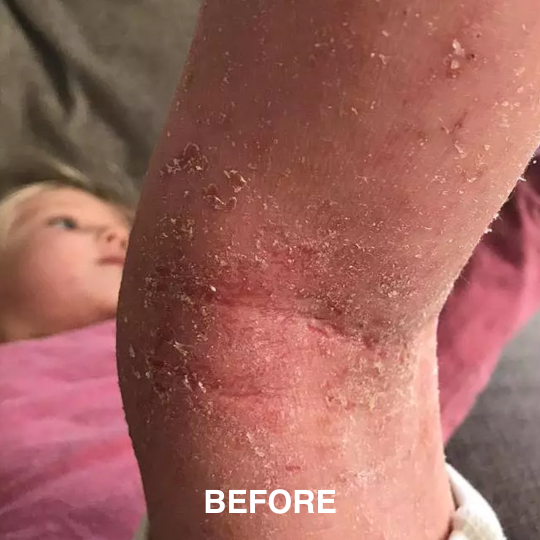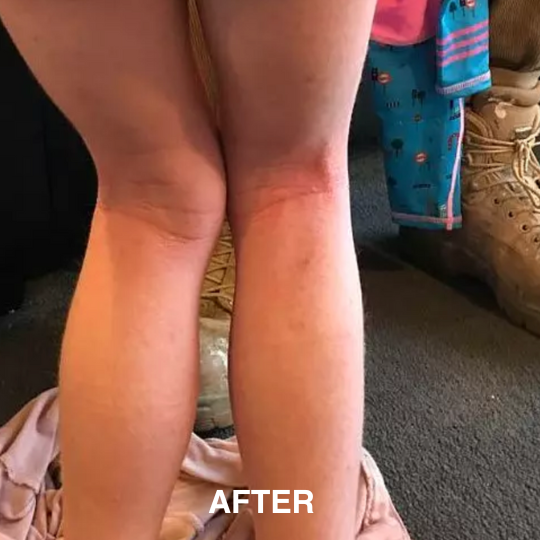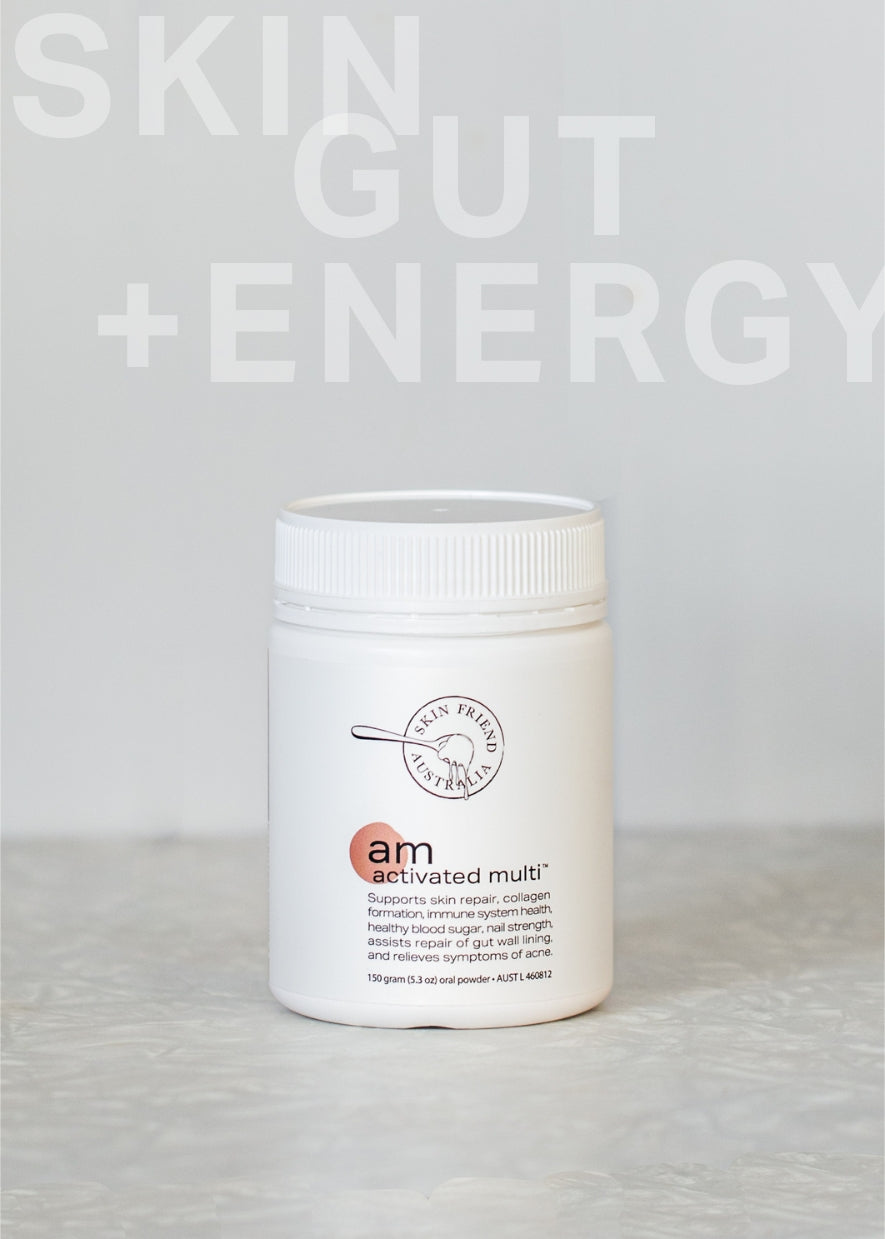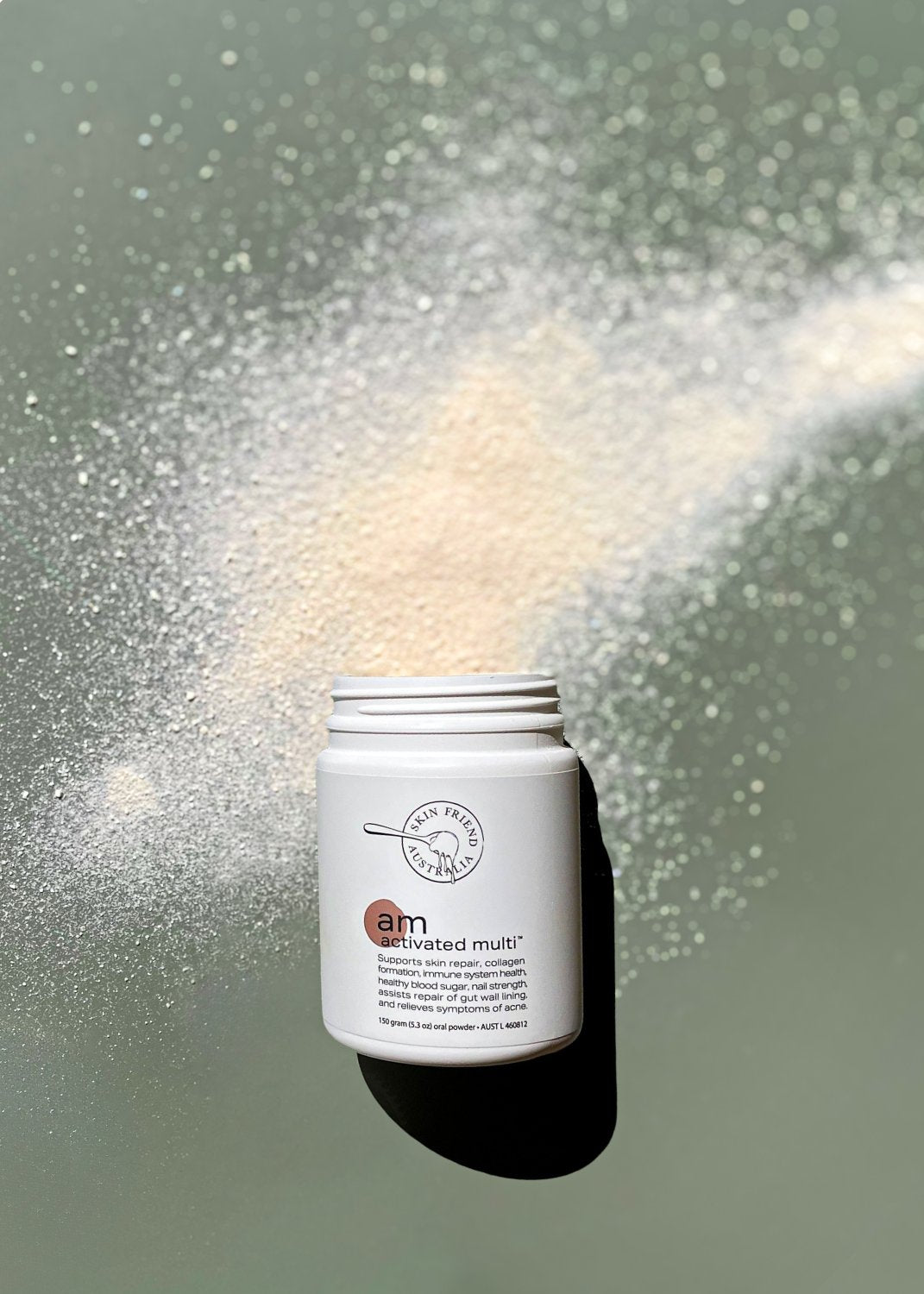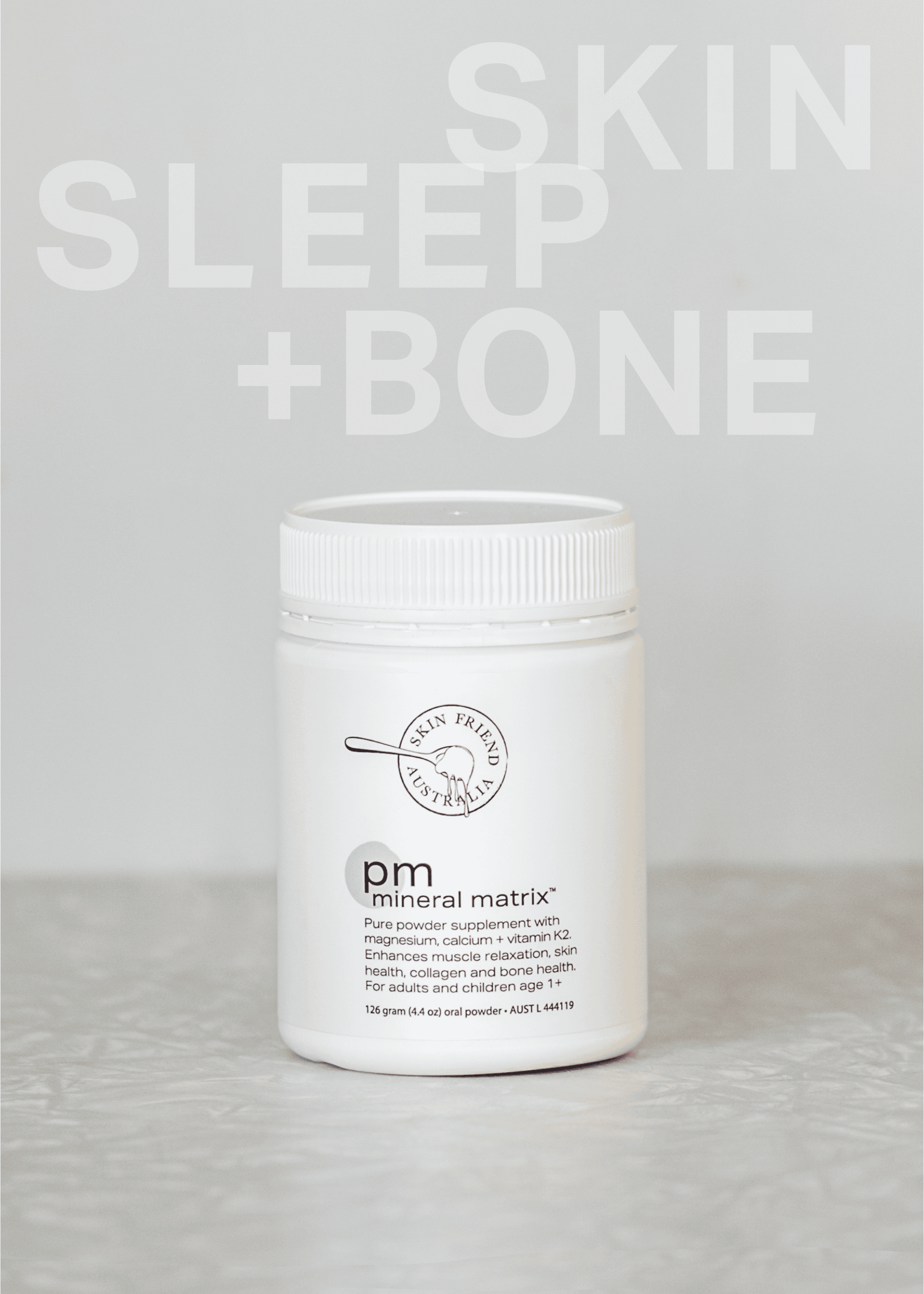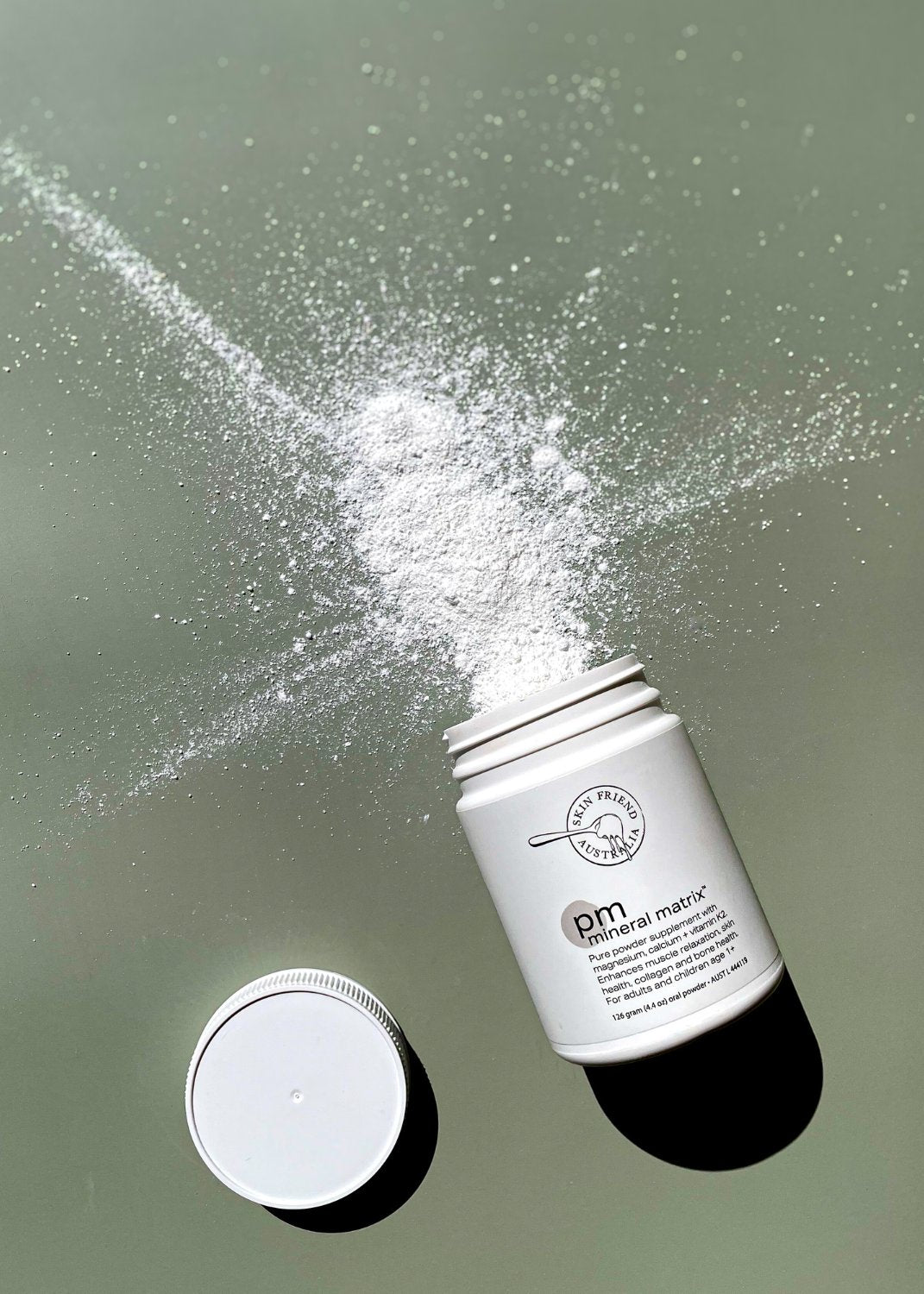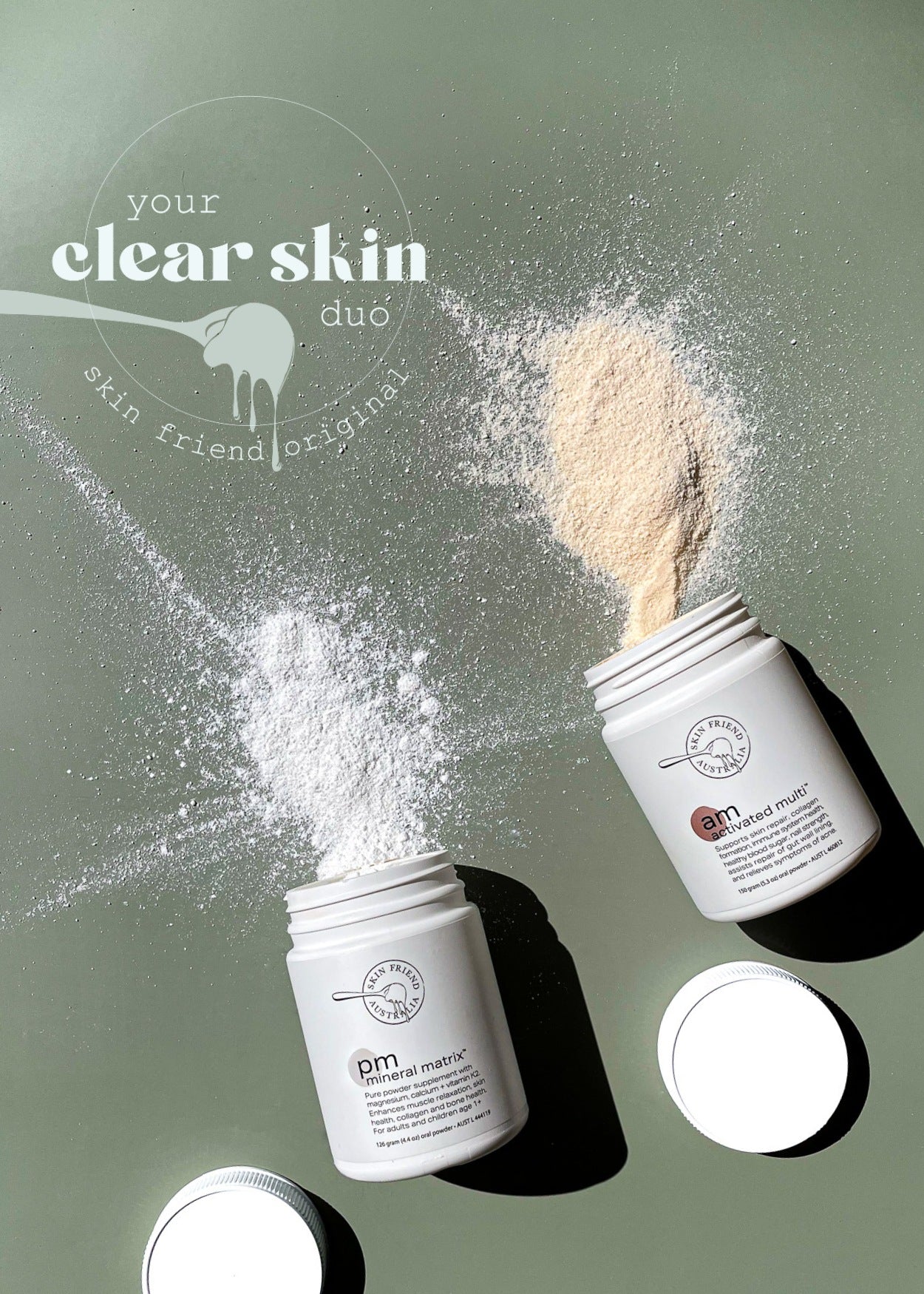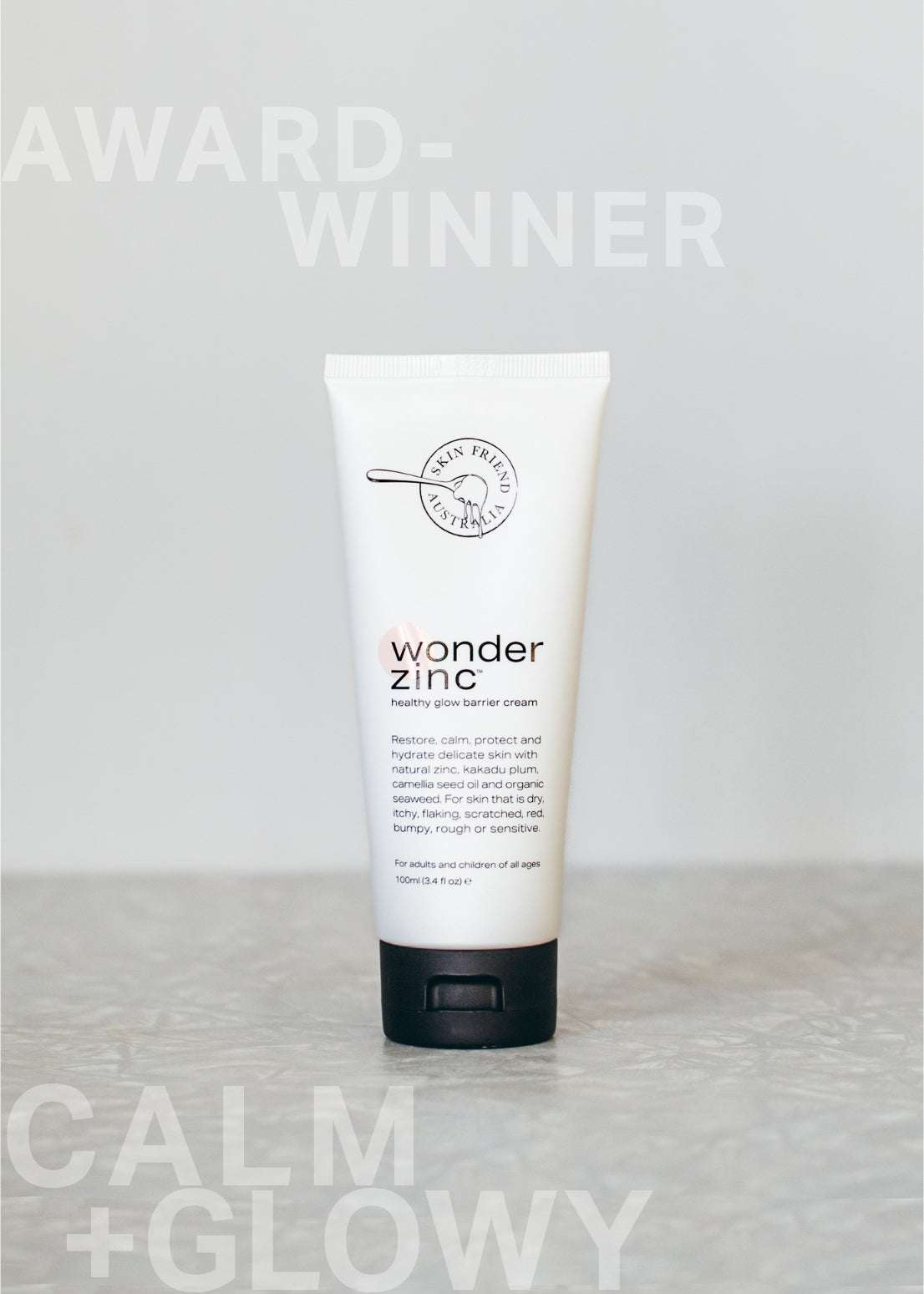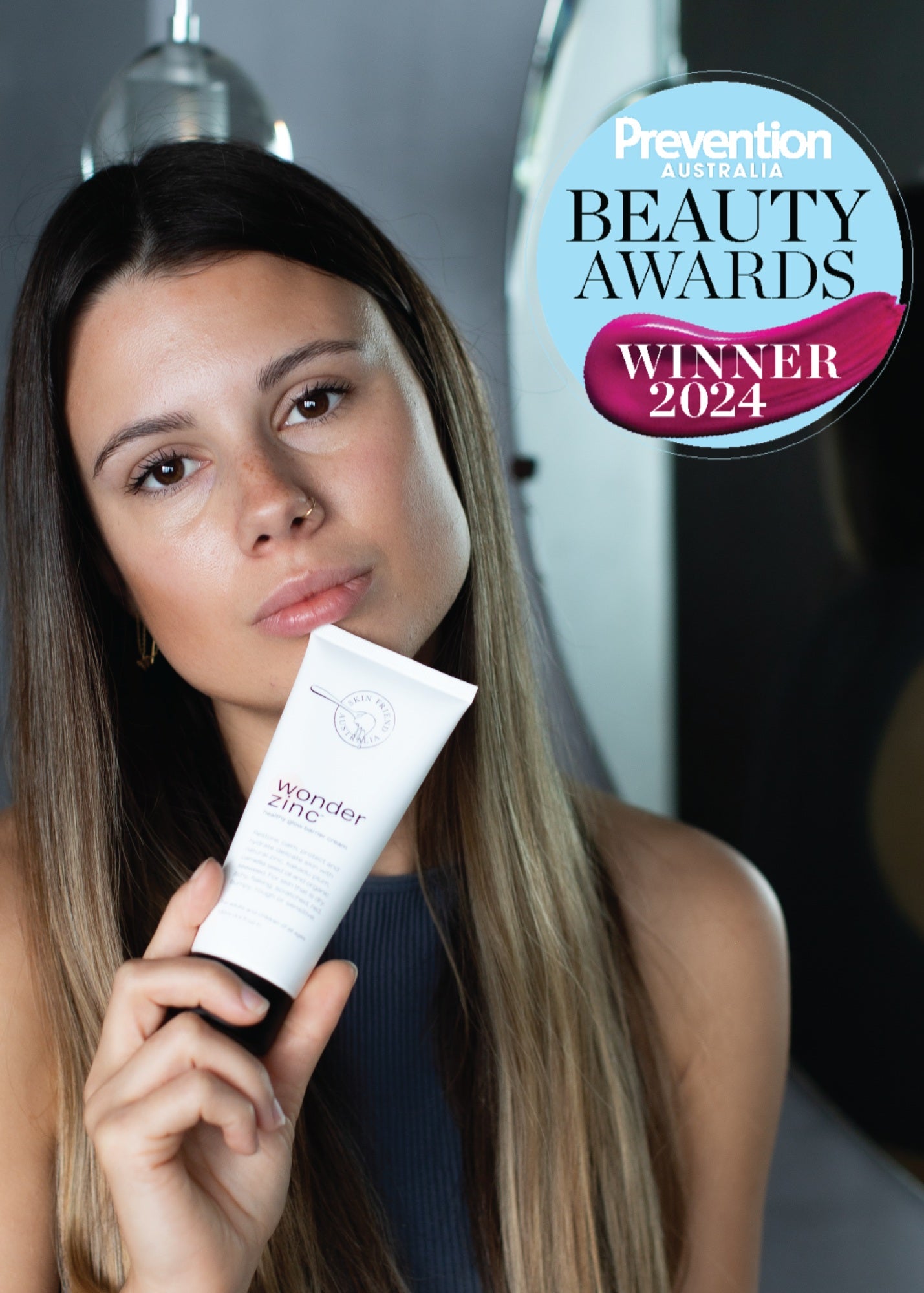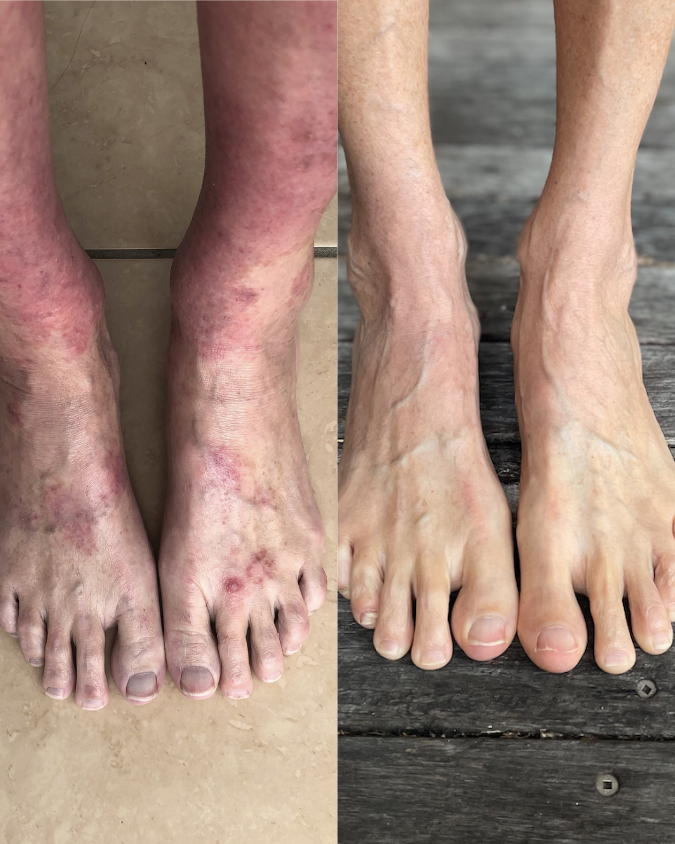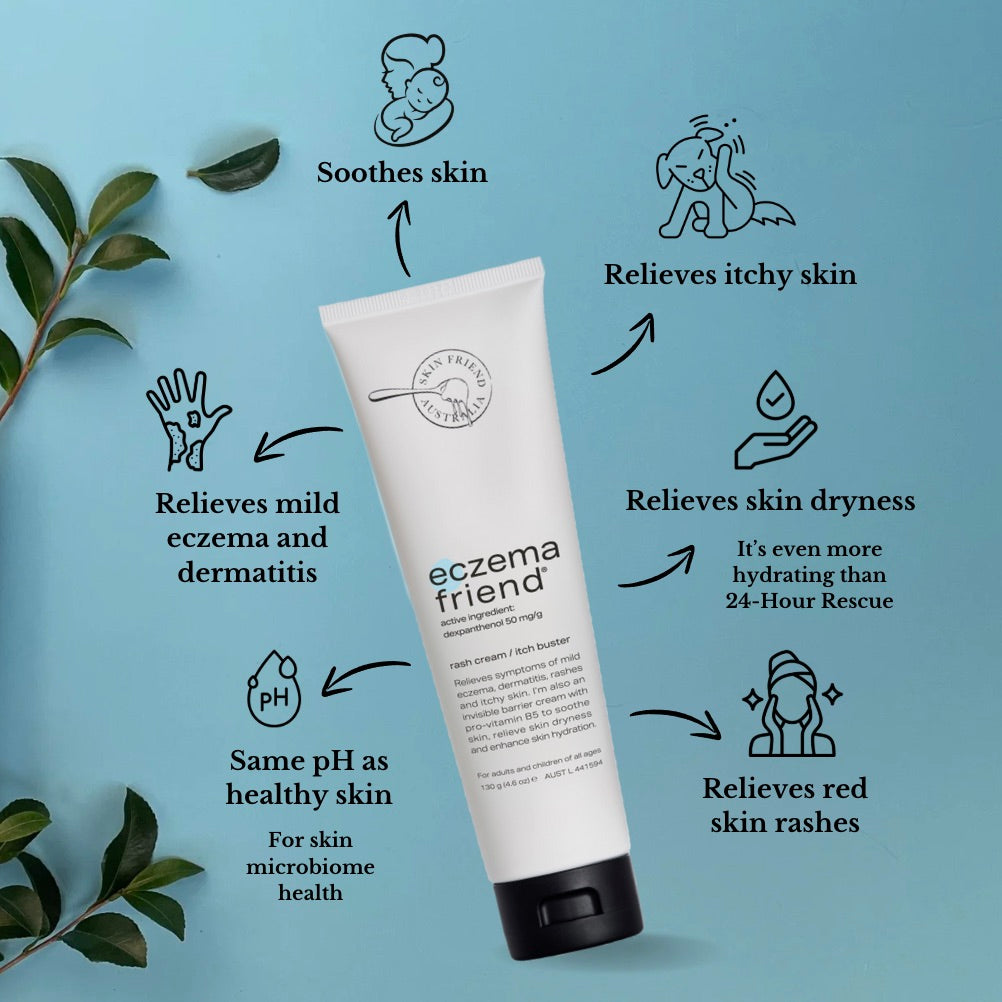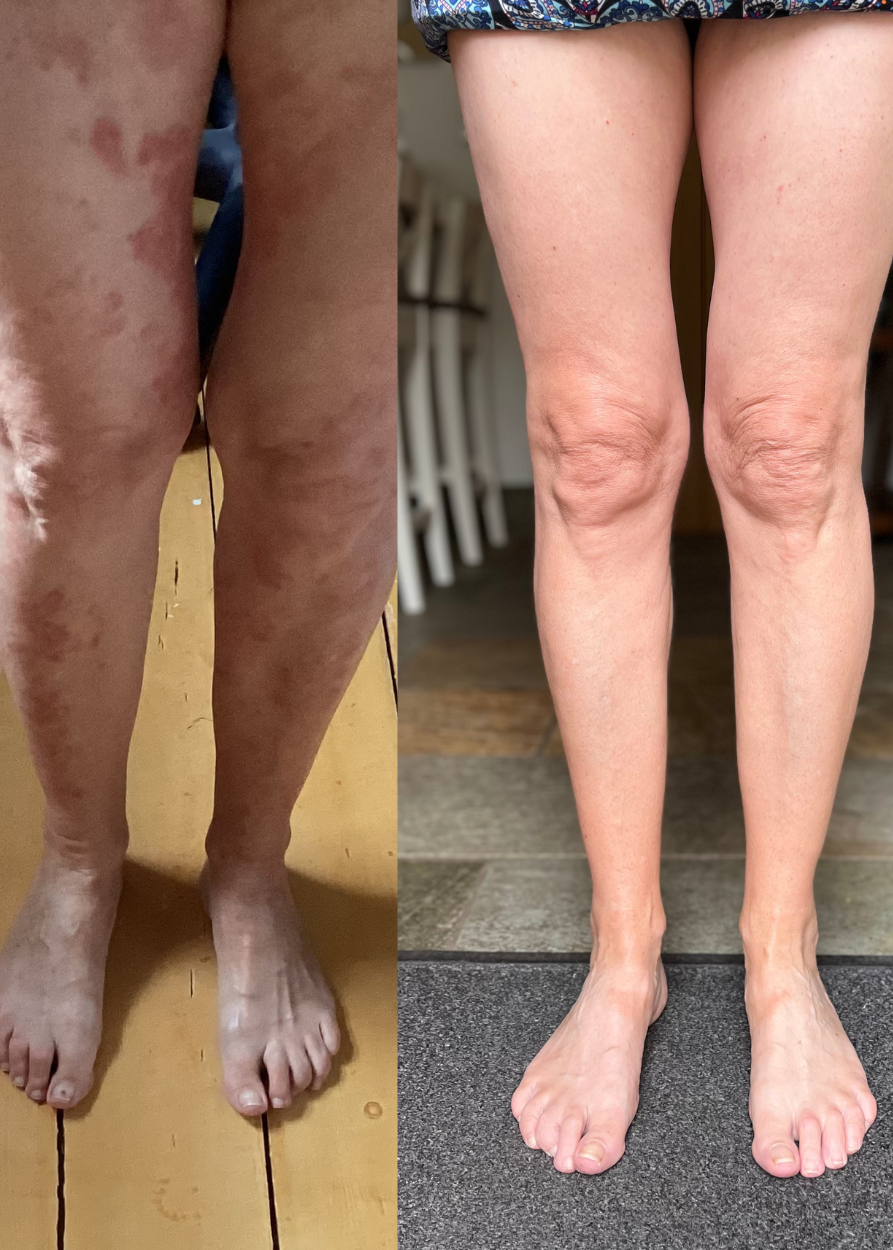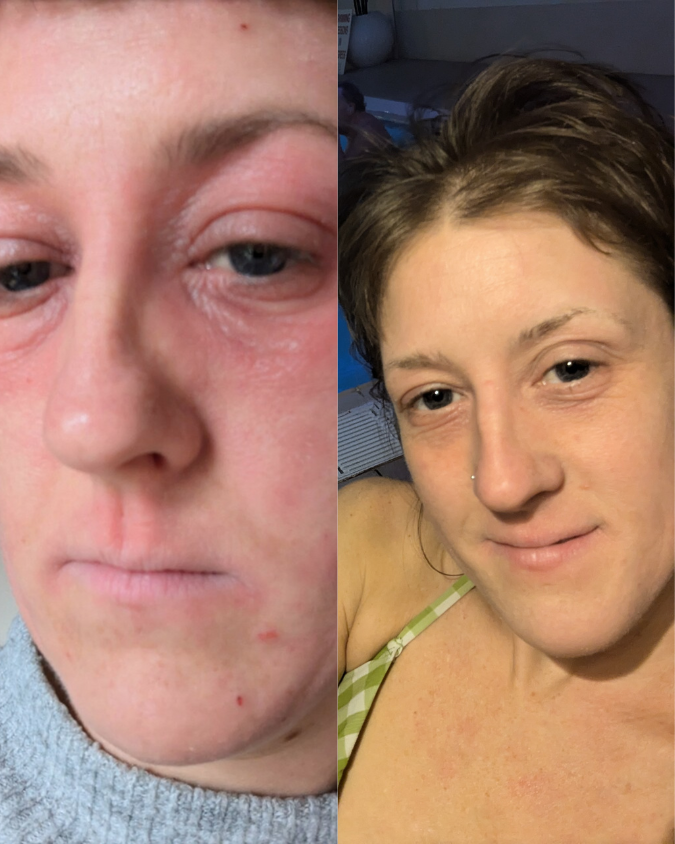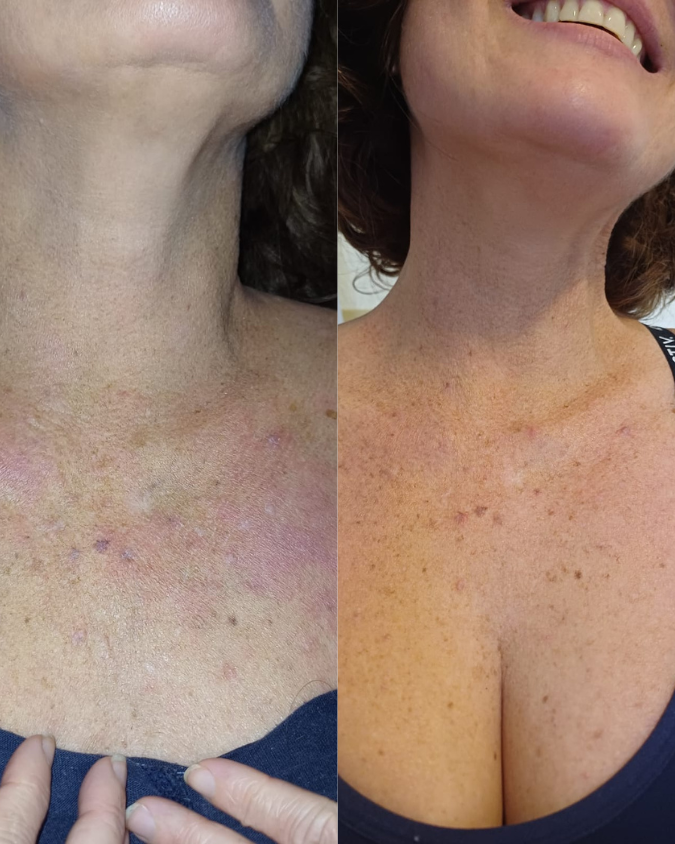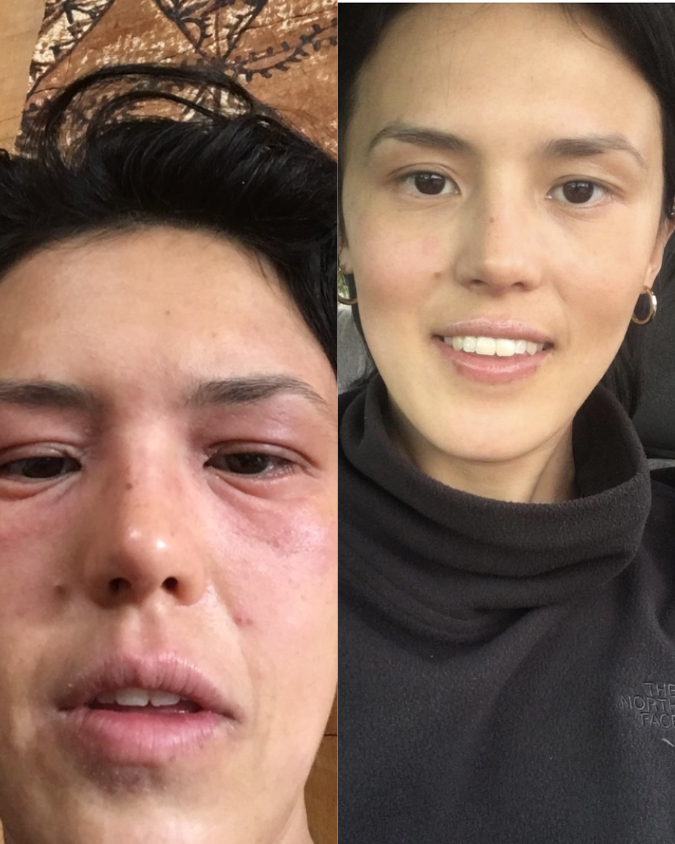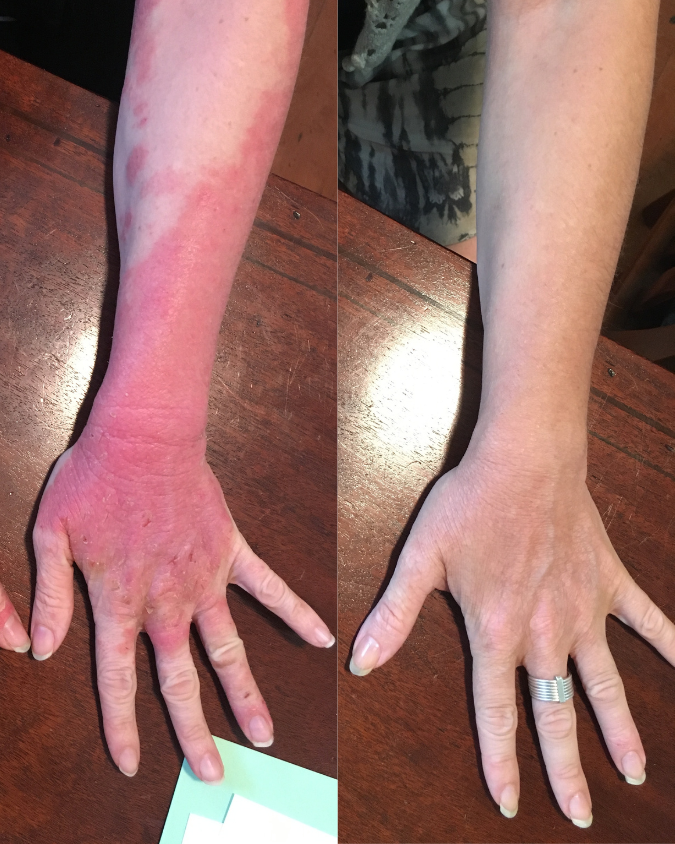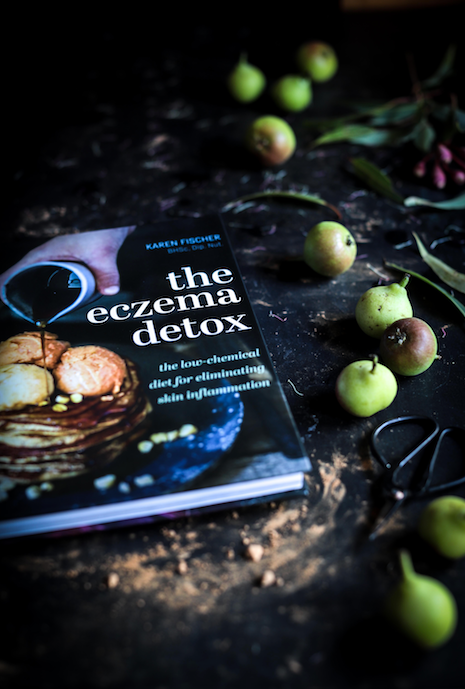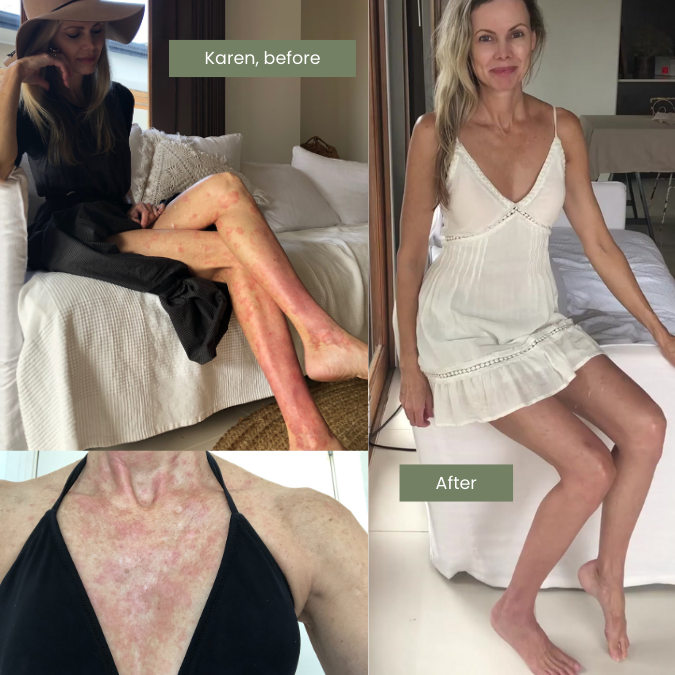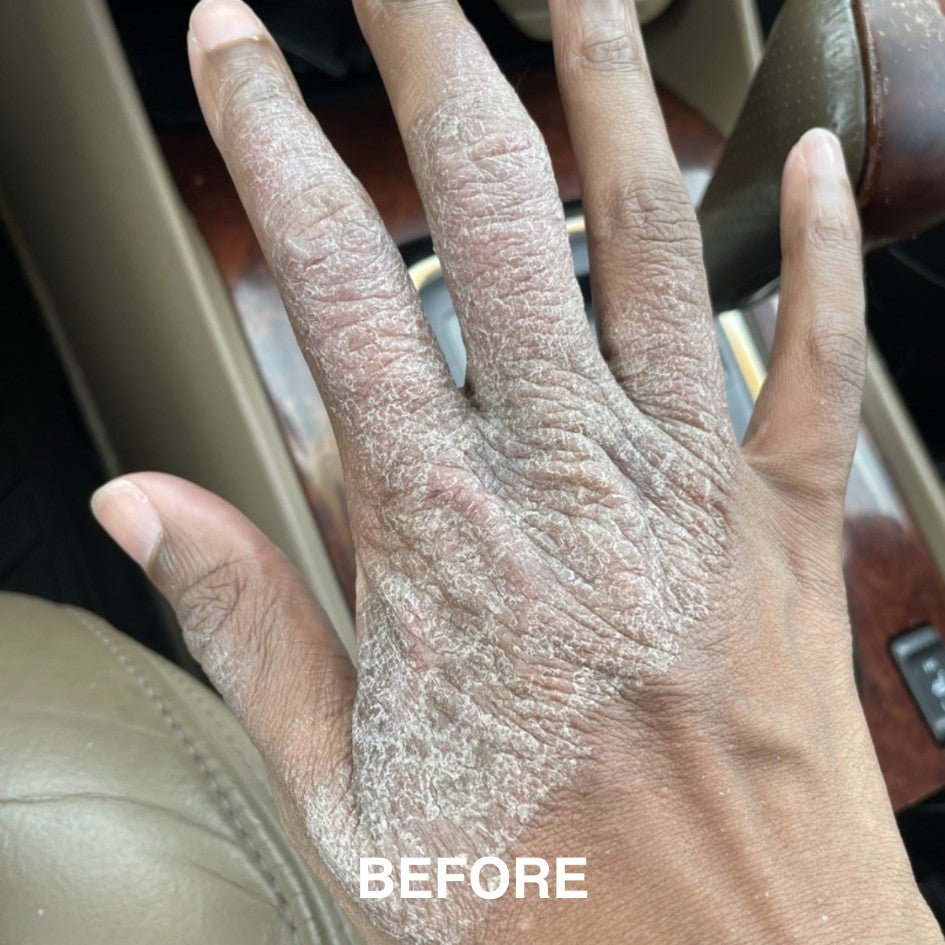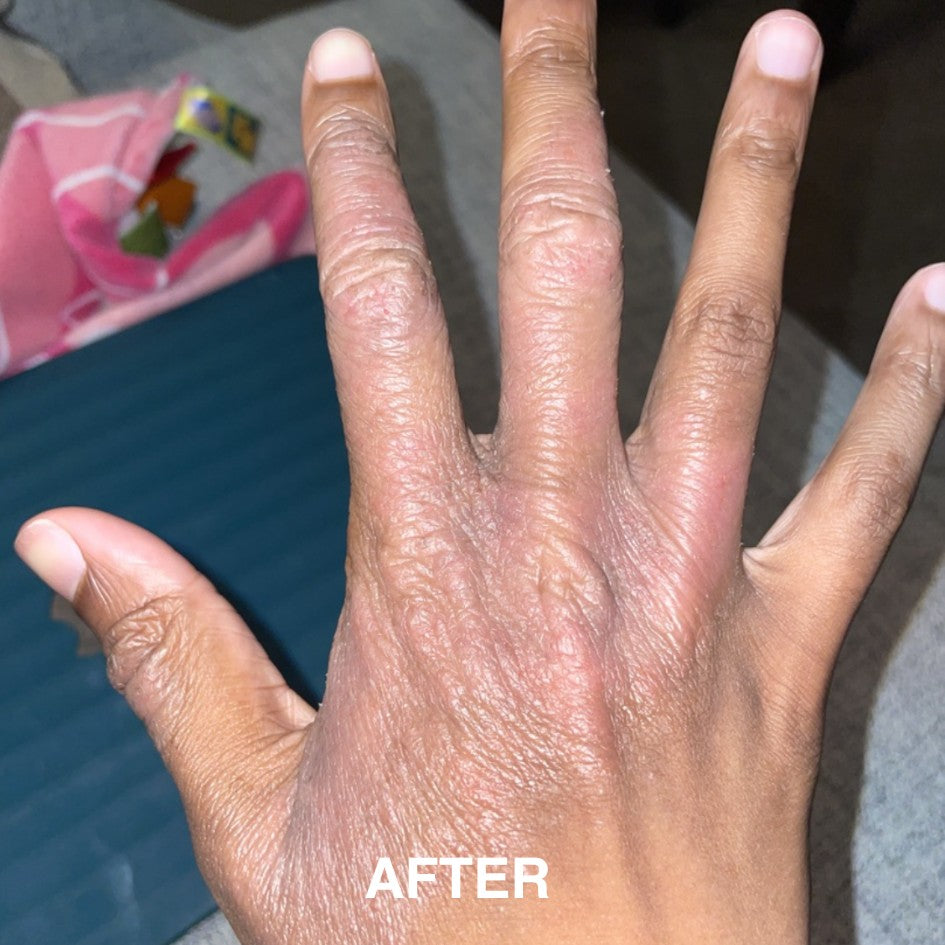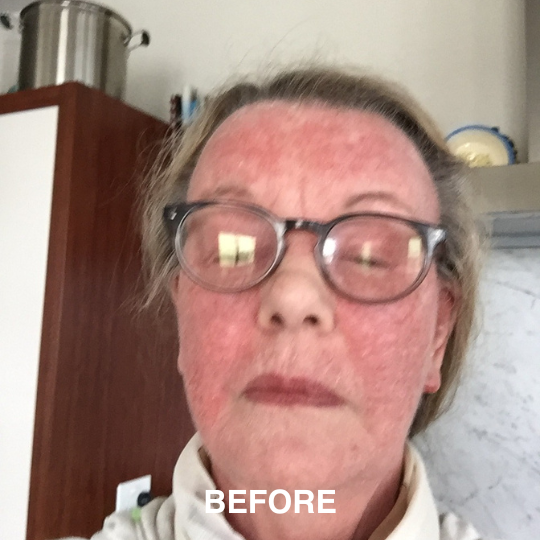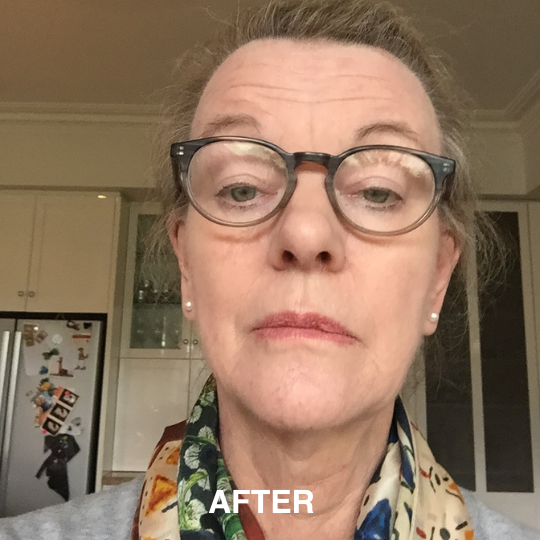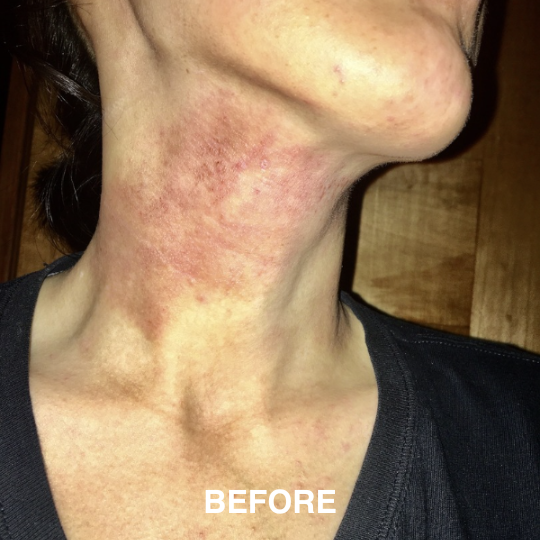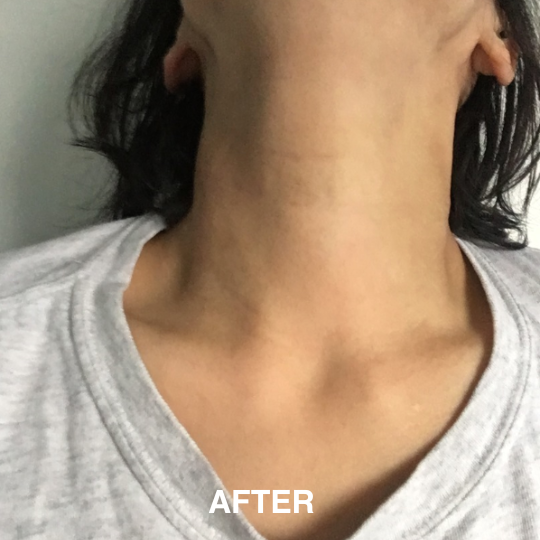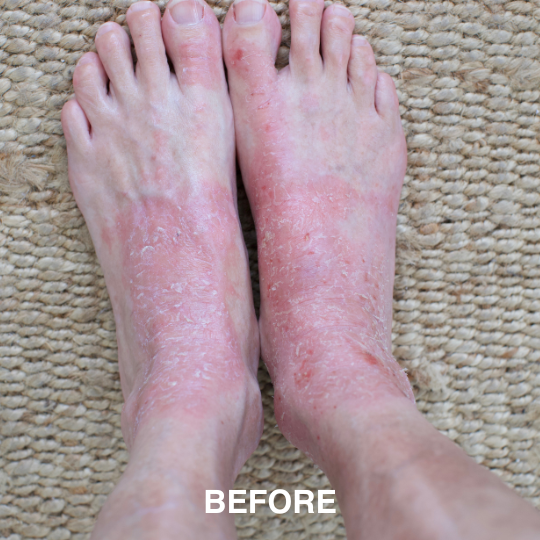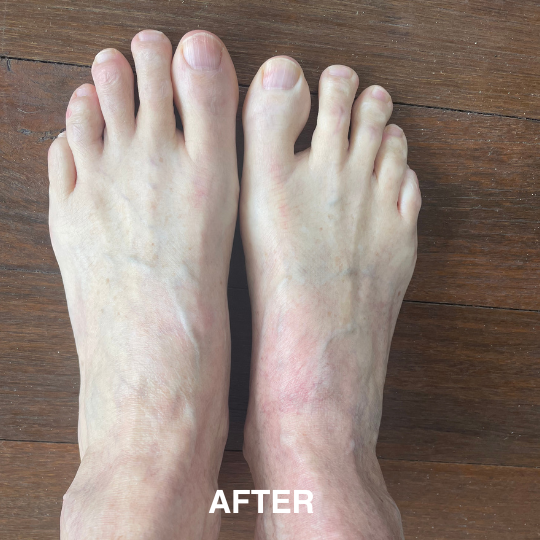
Is your health practitioner treating your skin with anti-fungal meds without addressing the real root cause of seborrheic dermatitis? While medications can be a helpful short-term fix, new research points to a deeper issue—and the good news is, it’s surprisingly simple to address.
As a nutritionist and researcher, I bust common myths and in this blog, I’ll share what’s really behind seborrheic dermatitis, including the overlooked symptoms in both light and darker skin tones, and natural solutions that no one’s talking about (not even AI—most sources just repeat outdated ideas!). If you have tried everything and nothing worked for you, this information could improve your life.
If you struggle with a flaky, itchy head or scalp eczema that just won’t go away, or maybe you’ve noticed red, irritated patches on your face or chest that seem to flare up without warning, then you could be dealing with seborrheic dermatitis. It’s a common skin condition that affects areas rich in oil glands, such as the scalp, face and upper chest. It’s often confused with dandruff or eczema, but it’s actually its own condition.
The good news is, there are natural, science-backed ways to calm your skin and reduce flare-ups, such as through a specific skincare routine for seborrheic dermatitis. Or, by supporting your body from the inside out, as recent studies show that seborrheic dermatitis and gut health and even nutritional deficiencies could be closely linked.
In this guide, we’ll explore what causes seborrheic dermatitis, and
- how to spot the symptoms,
- how to address the root causes to find long-term relief, and
- Diana’s heartbreaking story and how she beat seborrheic dermatitis and rosacea naturally, and what you can learn from this— it could change your life.

What Causes Seborrheic Dermatitis?
Seborrheic dermatitis usually develops due to a mix of factors, not one single cause. One of the most common theories is an overgrowth of Malassezia, a type of yeast that naturally lives on the skin. In some people, it can multiply too quickly, leading to irritation, inflammation and flaking.
Does Malassezia Yeast Cause Seborrheic Dermatitis?
Thanks to old studies, which perpetuated the myth, this yeast is still thought of as a ‘cause’ because it’s found on seborrheic dermatitis-affected skin in increased amounts. So most practitioners still target this yeast when treating seborrheic dermatitis—antifungals are prescribed but the problem keeps recurring, especially when corticosteroids are used.
Here’s what the science says:
Studies supporting this treatment plan are outdated and Malassezia is no longer considered the root cause of seborrheic dermatitis. New research shows it's not the yeast, but the individual’s immune system and skin barrier dysfunction that may instead be the root causes of seborrheic dermatitis. Because a dysfunctional immune system allows opportunistic pathogens, like Malassezia, to spread, so your microbiome gets hijacked.
Genetics, hormones, stress, environmental factors and nutritional deficiencies—which can impact your immune system—can also play a role.
Can Diet Help Seborrheic Dermatitis?
Yes, it can. As a clinical nutritionist I’ve found nutritional deficiencies can be one of the underlying causes of seborrheic dermatitis, because nutrition impacts a person’s immune system and skin barrier health. (One missing nutrient in your diet, such as zinc, and your microbiome and immune systems suffers) In many cases, targeted supplementation and tweaking their diet can bring rapid improvements in scalp and skin health within a few weeks (more on this shortly).
What the Science Says:
A recent study found that women who ate a typical Western diet containing processed foods, sugar and unhealthy fats were more likely to develop seborrheic dermatitis. This reinforces the idea that what you eat can directly affect your skin. Here’s a real-life example of how diet made a difference for someone struggling with seborrheic dermatitis:
Case Study: How Diana Found Relief from Seborrheic Dermatitis and Rosacea
Diana from New Zealand shared:
“For the past five years I’ve tried every topical remedy oil treatment and prescription shampoo known to man. I have tried many supplements and probiotic protocols, spent a lot of time, money and heartache trying to rid myself of this nasty embarrassing itch and flaky scalp. It’s not just dandruff, it's like barnacles growing on my head with a yellowish and dry aching grip on my head.
I have lost hair in the areas where I have the worst dermatitis and it’s been steadily getting worse the past few years. It’s very painful under the shower or swimming at the beach and every photo of me I’m scratching my head uncontrollably. Family say with a hard to conceal look of disgust that they have to get the vacuum out every time I leave 😔 I foolishly never even considered I could get rid of this with a diet and the correct supplements.
I was recommended from a commentator on a favourite skin YouTube channel to try Karen Fischer’s eczema diet for my Seborrheic Dermatitis. I ordered the suggested AM and PM from Skin Friend and got started on the FID diet. My seborrheic dermatitis was literally 70 % eradicated within ten days and as a side benefit my sleep was better, my bleeding gums were improved and my numb pins and needle feet were no more.
I also suffer from Rosacea and just thought I was stuck with it, however my entire face firmed up, rosacea gone completely on one side and just a small patch left on the other as well as my melasma around the perimeter of my face becoming very very faint. I feel good that it [Skin Friend PM] includes vitamin K as well, and after all I’ve spent on supplements I am delighted to find my holy grail.” You can find Diana’s full review here.
Diana’s story shows that even the most stubborn seborrheic dermatitis can dramatically improve when you identify your personal triggers—whether they’re dietary, environmental or nutritional—and make changes. If you're still experiencing symptoms, addressing the root causes may help improve your skin’s health. It’s never too late to start making changes—your journey to clearer, calmer skin could begin today. See the treatment plan below for gentle, effective steps.
The Symptoms of Seborrheic Dermatitis on Pale Skin Tones
Common signs and symptoms include:
- Scaly, dry or greasy patches on the scalp, face or other oily areas
- Cradle cap-like symptoms, with scaly plaques
- Dandruff
- Redness, inflammation and swelling on the affected areas
- Itching, burning and discomfort, which can lead to scratching and potential infections
- Crusting and/or oozing (in severe cases)
Seborrheic Dermatitis Symptoms on Darker or Black Skin
Seborrheic dermatitis is one of the most common skin conditions seen in people with darker skin tones. Here are the signs and symptoms of seborrheic dermatitis on dark skin:
-
Lighter (hypopigmented) patches: Instead of redness, the affected areas may appear lighter than the surrounding skin.
-
Ashy or dull-looking skin: The flaky or scaly patches may give the skin a dry, ashy appearance.
-
Mild to moderate scaling: Especially around the scalp, hairline, eyebrows, ears and nose.
-
Post-inflammatory pigmentation changes: After the inflammation settles, the skin may be left either darker (hyperpigmented) or lighter (hypopigmented) than usual. These pigment changes can last longer than the rash itself.
-
Itching or burning: The affected areas may feel itchy or irritated, with crusting and oozing, though not always.
-
Scalp symptoms: Dry scalp flakes, sometimes mistaken for dandruff, or patchy hair loss in more severe or untreated cases.
How to Treat Seborrheic Dermatitis
Because seborrheic dermatitis can have a range of underlying causes, those wondering how to heal scalp eczema (which is really seborrheic dermatitis) may find that a more holistic approach works best. That means developing a topical skincare routine designed specifically to calm your skin, such as with moisturisers for seborrheic dermatitis as well as focusing on supporting your body from within using diet and/or supplements.
Seborrheic Dermatitis and Gut Health
Emerging research suggests a connection between inflammatory skin conditions like seborrheic dermatitis and gut health. When the gut lining is compromised or the microbiome is compromised, it can lead to systemic inflammation, which may be reflected in the skin.
Here are a few ways to support your gut:
-
Omega-3 Fatty Acids: Incorporate foods rich in omega-3s, like flaxseeds and fish, to reduce Inflammation. However, omega-3 needs supporting nutrients, especially vitamin B6, to convert omega-3 into anti-inflammatory substances—so omega-3 won’t work on its own.
-
Stress Management: Techniques like meditation and exercise can help prevent flare-ups triggered by stress.
-
Nutrient Support: Nutrient deficiencies, especially in zinc, vitamin K2 and vitamin B6, are linked to both poor gut health and chronic skin conditions. Supplements from Skin Friend can help correct these imbalances and support skin repair and assist with the repair of the gut wall lining.
Do Probiotics Help with Seborrheic Dermatitis or Gut Health?
Gut health plays an important role in skin conditions like seborrheic dermatitis, especially since gastrointestinal issues (like irritable bowel syndrome) can lead to B vitamin deficiencies. But despite their popularity, probiotics aren’t a magic fix for gut health. That’s because your existing gut microbes thrive not on an influx of new bacteria, but on the right nourishment—meaning dietary changes are far more effective than simply taking a probiotic, for true gut wellness.
If you need to take antibiotics, consider taking vitamin K2 (menaquinone-7) at the same time. A recent study found that K2 helps protect the gut and brain from antibiotic-related damage by preserving good bacteria, reducing inflammation and protecting brain cells. It’s one reason why vitamin K2 is a key ingredient in Skin Friend supplements—because a healthy gut supports not just clearer skin, but your overall wellbeing.

Can Vitamin Deficiencies Cause Seborrheic Dermatitis?
Yes, they can. B-group vitamins play a vital role in skin health, and deficiencies in certain B vitamins—particularly B2 (riboflavin), B6 (pyridoxine) and B7 (biotin)—have been linked to seborrheic dermatitis.
Ensuring you get enough B vitamins through targeted supplementation may help calm symptoms and support long-term skin health. But more isn’t always better. Many supplements contain mega-doses of B vitamins, which can throw your body’s biochemistry out of balance and, in some cases, cause harm.
For example, high-dose vitamin B6 (typically over 10 mg per day) can cause peripheral nerve damage—leading to symptoms like tingling, numbness or pins and needles in the hands and feet. After years of concern from practitioners like myself, the TGA has finally addressed this issue—one that many doctors and even naturopaths have overlooked for far too long. That’s why I formulated AM Activated Multi with safe amounts of B vitamins to support skin health, without compromising overall health.
Can Zinc Deficiency Cause Seborrheic Dermatitis?
Yes, absolutely. Recent studies suggest that deficiencies in key nutrients—especially zinc—may contribute to the development of seborrheic dermatitis (Kashiri, 2024).
Zinc assists in the healing of the gut wall lining and is arguably one of the most important nutrients for gut health, with strong scientific backing for its role in maintaining gut barrier integrity. Zinc also plays an important role in skin integrity, immune function and wound healing.
Diana used this zinc and B vitamin supplement, along with diet, to ease her seborrheic dermatitis and rosacea.
Skincare Routine for Seborrheic Dermatitis
When it comes to a skincare routine for seborrheic dermatitis, it’s best to choose products that support the skin barrier without any harsh chemicals, fragrances, PFAS (forever chemicals) or benzoates. Keeping your routine simple and consistent is key.
-
Gently Cleanse: Use a fragrance-free and pH-balanced cleanser—a pH between 4.0 and 5.0 is ideal because a higher pH damages the skin’s microbiome. Look for ingredients like citric acid or lactic acid as they lower the pH of a product.
-
Avoid foaming shampoos with sulfates (SLS or SLES), which can strip natural oils and irritate skin.
-
Avoid regular soap: soap and poorly formulated washes have a pH above 6.0, which causes the skin’s microbiome to dislodge, increasing the risk of opportunistic microbes like Malassezia to proliferate on seborrheic dermatitis-affected skin.
-
Moisturise: Regularly apply a pH optimised moisturiser for seborrheic dermatitis on any inflamed areas to maintain your skin’s hydration.
-
Dexpanthenol (Pro-Vitamin B5): Look for skin creams containing this skin-repairing vitamin, such as Eczema Friend or Wonder Zinc. Dexpanthenol helps restore the skin barrier and hydrate dry patches effectively.
Worst Oils for Seborrheic Dermatitis: What to Avoid
Common oils like coconut oil, almond oil and squalane should be avoided on your scalp, as squalane may trigger irritation and some food-based oils may increase the risk of developing food allergies.
Also avoid applying olive oil to your skin.
A clinical study published in Pediatric Dermatology found that applying olive oil to the skin significantly damaged the skin barrier and caused mild inflammation—even in people without eczema. In contrast, sunflower oil improved hydration and maintained skin barrier integrity. These findings suggest that olive oil can worsen conditions like seborrheic dermatitis, and its use should be avoided—even though it’s often thought of as a natural remedy.
Can Zinc Creams Help with Cradle Cap and Seborrheic Dermatitis?
Yes it can, but ensure the zinc cream contains non-nano zinc oxide, sunflower oil and provitamin B5 (dexpanthenol) for more targeted barrier repair and symptom relief—combined with nutritional support, as mentioned earlier. Ensure the zinc oxide cream for skin health is labelled “non-nano” as nano particles should not be applied to broken skin such as dermatitis as it may penetrate too deeply and cause irritation.
Wonder Zinc contains sunflower oil, non-nano zinc oxide, provitamin B5 and organic seaweed extract to reduce skin redness and support the microbiome, making it a more targeted option that helps calm red, flaky skin while supporting the natural skin barrier.
If symptoms persist, consult your healthcare provider.
Skin Friend’s Natural Eczema Creams and Supplements
Managing eczema takes more than a quick-fix cream. At Skin Friend, we offer a two-step approach: calm the skin externally and support it from within.
Our steroid-free Zinc Rash Cream soothes irritation and helps to restore the skin barrier without harsh chemicals. Paired with our skin and gut health supplements, including zinc, vitamin B2, vitamin B6, biotin and vitamin K2, you can target seborrheic dermatitis and gut health at the root, not just the surface.
As a parent and a nutritionist, I understand how exhausting it is to deal with ongoing skin flare-ups—especially when nothing seems to help. That’s why it’s so important to support your skin from the inside out. It’s not about quick fixes or trendy gimmicks—it’s about true skin wellness and finally feeling calm, confident and comfortable in your own skin.
Let’s spread the word
If you know someone who’s struggling, feel free to share this article. Everyone deserves to enjoy life—without scaly, uncomfortable skin holding them back.
Click for references
Fischer, Karen, Mark Jones, and Hayley M. O’Neill. 2025. "Prevalence of Intolerance to Amines and Salicylates in Individuals with Atopic Dermatitis: A Systematic Review and Meta-Analysis". Nutrients, 17(10):1628. https://doi.org/10.3390/nu17101628
Woolhiser E, Keime N, Patel A, Weber I, Adelman M, Dellavalle RP. Nutrition, Obesity, and Seborrheic Dermatitis: Systematic Review. JMIR Dermatol. 2024 Aug 5;7:e50143. doi: 10.2196/50143. PMID: 39102684; PMCID: PMC11333864.
Elewski BE. Safe and effective treatment of seborrheic dermatitis. Cutis. 2009 Jun;83(6):333-8. PMID: 19681345.
Chang CH, Chovatiya R. More yeast, more problems?: reevaluating the role of Malassezia in seborrheic dermatitis. Arch Dermatol Res. 2024 Mar 12;316(4):100. doi: 10.1007/s00403-024-02830-7. PMID: 38472524.
Kashiri A, Maghsoudloo N. Exploring the Impact of Vitamin D and Zinc Deficiencies on Seborrheic Dermatitis: A Comparative Study. Health Sci Rep. 2024 Dec 24;7(12):e70283. doi: 10.1002/hsr2.70283. PMID: 39720239; PMCID: PMC11667214.
McNulty H, Pentieva K, Ward M. Causes and Clinical Sequelae of Riboflavin Deficiency. Annu Rev Nutr. 2023 Aug 21;43:101-122. doi: 10.1146/annurev-nutr-061121-084407. PMID: 37603429.
Stone, O.J. (1989). Pyridoxine deficiency and antagonism produce increased ground substance viscosity with resulting seborrheic dermatitis and increased tumor resistance. Medical Hypotheses, 30(4).
Trüeb, Ralph M. Serum Biotin Levels in Women Complaining of Hair Loss. Int J Trichology. 2016 Apr–Jun;8(2):73-77. doi: 10.4103/0974-7753.188040.
Danby SG, AlEnezi T, Sultan A, Lavender T, Chittock J, Brown K, Cork MJ. Effect of olive and sunflower seed oil on the adult skin barrier: implications for neonatal skin care. Pediatr Dermatol. 2013 Jan-Feb;30(1):42-50. doi: 10.1111/j.1525-1470.2012.01865.x. PMID: 22995032.
Zhao M, Ralat MA, da Silva V, Garrett TJ, Melnyk S, James SJ, Gregory JF 3rd. Vitamin B-6 restriction impairs fatty acid synthesis in cultured human hepatoma (HepG2) cells. Am J Physiol Endocrinol Metab. 2013 Feb 15;304(4):E342-51. doi: 10.1152/ajpendo.00359.2012. PMID: 23211517; PMCID: PMC3566509.
Chatterjee K, Mazumder PM, Sarkar SR, Saha R, Chatterjee A, Sarkar B, Banerjee S. (2023). Neuroprotective effect of Vitamin K2 against gut dysbiosis associated cognitive decline. Physiol Behav. 269:114252. https://doi.org/10.1016/j.physbeh.2023.114252
Allergy & Anaphylaxis Australia. (2024, August 16). Development of food allergy through food-based skincare products. Retrieved 30 May 2025 from https://allergyfacts.org.au/development-of-food-allergy-through-food-based-skincare-products/







